Blockchain development is the process of building decentralized applications (DApps) that run on a peer-to-peer network of computers (nodes), leveraging the principles of cryptography to keep transactions secure. On the other hand, Python is a high-level, interpreted programming language known for its readability and versatility. So, what does it mean when we talk about blockchain development with Python? Essentially, it refers to using Python programming language for creating blockchain applications. The rationale behind this choice lies in Python's simplicity and breadth of features, which make it an excellent tool for blockchain development, particularly for developers seeking to learn the ropes or quickly prototype their ideas. Python offers a delicate balance between simplicity and robust capabilities, making it a go-to choice for many blockchain developers. The interplay of blockchain development and Python, a versatile programming language, contributes significantly to the operations and applications of blockchain technology. Even though blockchain can be programmed with various languages, Python's prominence is largely due to its simplicity and potent functionalities. Python streamlines the development process and bolsters debugging with its readability and uncomplicated syntax, making the coding experience more efficient for developers. The extensive library ecosystem of Python plays a significant role in revolutionizing blockchain development. These libraries provide a wide range of tools that greatly facilitate and expedite the development process, making Python a preferred choice among developers in the blockchain community. One of the key libraries for blockchain development is hashlib, which allows developers to craft robust hash functions. Hashlib provides functions for generating hash values, which are crucial for ensuring data integrity and security within the blockchain. Another important library is binascii, which enables binary and ASCII conversions. This functionality is essential when dealing with data that needs to be represented in different formats within the blockchain. Binascii simplifies the process of converting data between binary and ASCII formats, providing seamless interoperability. Furthermore, the ECDSA library is highly valuable in blockchain programming as it enables the generation and verification of digital signatures. Digital signatures play a crucial role in ensuring the authenticity and integrity of transactions within the blockchain. ECDSA offers functions that simplify the process of creating and validating digital signatures, enhancing the security and trustworthiness of the blockchain system. Python's extensive library ecosystem, including hashlib, binascii, and ECDSA, empowers blockchain developers by providing them with essential tools to effectively build, secure, and operate blockchain applications. These libraries contribute to the efficiency and reliability of Python in blockchain development, making it a popular choice among developers in the field. The core processes of creating blocks, implementing proof of work, and managing transactions are integral to blockchain development with Python. These processes form the foundation of a functioning blockchain system and can be efficiently executed using Python's comprehensive features and libraries. Creating blocks involves storing data within individual blocks, which are then linked together to form the blockchain. Python's capabilities in handling data structures and organizing information make it well-suited for this task. Implementing a proof-of-work system is crucial for achieving consensus and validating new blocks. Python's versatility and extensive library ecosystem allow developers to effectively implement this consensus mechanism, ensuring the security and integrity of the blockchain. Managing transactions involves handling and recording the transfer of assets or information within the blockchain. Python's robust features, such as its ability to handle data processing and manipulate data structures, streamline the transaction management process. Python's strengths in these core processes simplify the complexity of building robust and secure blockchains. Its comprehensive features and libraries provide developers with the tools necessary to efficiently carry out these fundamental operations, resulting in the creation of reliable and secure blockchain systems. In addition to creating blocks and managing transactions, Python also plays a crucial role in the networking aspect of blockchain technology. It has socket programming capabilities that empower blockchain developers to set up and maintain peer-to-peer networks. Such networks enable nodes to communicate and synchronize data, thereby upholding the decentralized nature of blockchain technology. Before beginning the journey of writing a blockchain application, it is essential to configure a Python development environment. This process includes installing Python and the requisite libraries on a local machine. It's also advisable to utilize a Python Integrated Development Environment (IDE), such as PyCharm or Atom, which provides a comprehensive toolset for writing and testing code. Once the Python environment is set up, writing a basic blockchain script is the initial step in developing a blockchain application. This involves defining a Block class that will store block data and a Blockchain class to manage the chain of blocks. Python's class-based object-oriented programming is particularly useful here as it simplifies the definition and manipulation of these data structures. The next phase in creating a blockchain application is the implementation of transaction functionality. This is accomplished by creating a transaction class to represent transactions and modifying the blockchain class to accommodate transactions. These transactions are typically validated before being added to the block, ensuring the data's integrity. Security is a top priority in blockchain development. Python provides several features like hash functions and digital signatures to safeguard transactions and prevent fraud. Moreover, a consensus algorithm, such as Proof of Work, is often integrated into the blockchain to validate new blocks. Implementing these security features with Python involves using libraries like hashlib and ECDSA and applying complex cryptographic principles. One of the significant advantages of Python in blockchain development is its accessibility and readability. Python's syntax, known for its clean design, makes it ideal for beginners and simplifies maintenance and debugging, a crucial benefit for complex projects. Python's vast standard library, supplemented by many third-party libraries, provides developers with tools. These libraries, offering pre-built functionalities for various tasks, can drastically reduce the development time and allow developers to focus on more critical aspects of the blockchain application. The adaptability of Python makes it a suitable choice for constructing a wide range of blockchains. Whether a simple, single-purpose chain or a complex, multipurpose chain like Ethereum, Python has the tools and features necessary for the task. Although Python might not outperform specific other languages in speed, it strikes a good balance between performance and productivity. When efficiently coded and using appropriate libraries, Python-based blockchain applications can manage large volumes of transactions while maintaining acceptable performance levels. Despite its numerous advantages, Python has limitations when used for blockchain development. One notable drawback is its slower performance relative to compiled languages like C++ or Go. This might not pose an issue for smaller applications, but it could be a bottleneck for large-scale blockchains that need to process millions of transactions. While Python provides many tools for secure programming, it isn't impervious to security vulnerabilities. Poor coding practices can lead to security issues in any language, and Python is no exception. Therefore, adhering to secure coding practices and meticulously testing the application for potential security vulnerabilities is vital. While Python is capable of powering small-scale blockchain applications, it may need help to scale for larger, more complex blockchains. As the size and complexity of the blockchain grow, so do the computational demands. In these scenarios, lower-level languages known for their speed and efficiency, like C++ or Rust, might be better suited. Security is an integral component of any blockchain application. Python's libraries and tools allow developers to secure data and transactions effectively. Libraries such as hashlib provide hashing functions that can be used for data integrity checks and digital signatures, ensuring the authenticity of transactions. Additionally, Python's support for strong encryption algorithms aids in protecting sensitive data, making it more challenging for malicious parties to compromise the system. Python's SSL library provides a robust platform for using Secure Sockets Layer (SSL) and Transport Layer Security (TLS) protocols. These cryptographic protocols enhance the security of data transmission in blockchain networks by providing end-to-end encryption. Implementing SSL/TLS using Python contributes to the overall resilience of a blockchain against potential cyberattacks. Beyond applying encryption and secure protocols, it's crucial to adopt secure coding practices. Python's simplicity and readability make it easier to implement such practices. Adhering to best practices like input validation, error handling, and regular code reviews helps mitigate common vulnerabilities and prevent potential security breaches. Smart contracts are self-executing contracts where the terms of an agreement are directly written into lines of code. In the context of blockchain, these digital contracts facilitate, verify, or enforce the negotiation or performance of a contract without third parties. Python's expressiveness and simplicity make it a desirable language for defining the logic of these contracts. Although Solidity is the most commonly used language for writing smart contracts on Ethereum, Python too can interact with these contracts. The Python library web3.py facilitates the interaction between Python and Ethereum, making it possible to deploy and manage smart contracts using Python. Despite Python not being the primary language for writing Ethereum smart contracts, its tools, and libraries provide a robust platform for interacting with them. Decentralized applications, or DApps, are built on a blockchain that leverages features like decentralization, immutability, and transparency. Python's capabilities extend well to the DApps realm. Using Python, developers can build server-side applications that interact with a blockchain, enabling the development of more complex, interactive DApps. Python has emerged as a powerful and versatile programming language for blockchain development. Its simplicity, readability, and extensive library ecosystem make it an excellent choice for building decentralized applications. The key libraries in Python, such as hashlib, binascii, and ECDSA, provide essential functionalities for ensuring data integrity, handling conversions, and implementing secure digital signatures. Python's core processes, including creating blocks, implementing proof of work, and managing transactions, form the foundation of a functional blockchain system. Additionally, Python's networking capabilities enable the establishment of peer-to-peer networks, maintaining the decentralized nature of blockchain technology. Python brings benefits like accessibility, library availability, and versatility in blockchain development, but it also has drawbacks in speed, security vulnerabilities, and scalability for complex blockchains. By leveraging Python's strengths and adhering to secure coding practices, developers can harness the power of Python in blockchain development to create robust, secure, and efficient blockchain applications.What Is Blockchain Development With Python?
How Blockchain Development With Python Works
Understanding Python's Role in Blockchain Development
Key Python Libraries for Blockchain Development
Hashlib
Binascii
Elliptic Curve Digital Signature Algorithm (ECDSA)
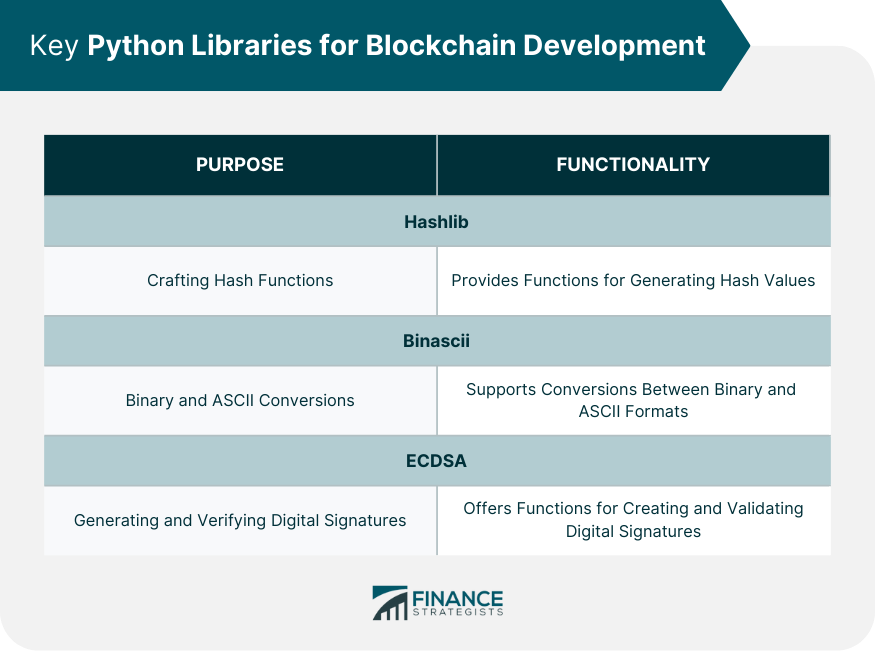
Core Processes in Blockchain Development With Python
Create Blocks
Implement Proof of Work
Manage Transactions
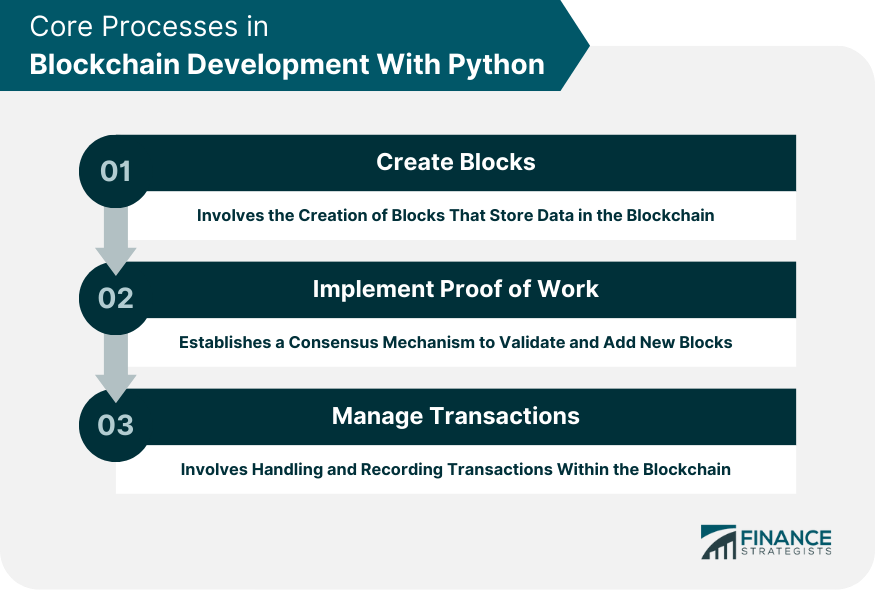
Blockchain Networking With Python
Basics of Writing a Blockchain Application in Python
Setting up Python Environment for Blockchain
Writing a Simple Blockchain Script
Implementing Transaction Functionality
Enhancing Security and Validation in the Blockchain
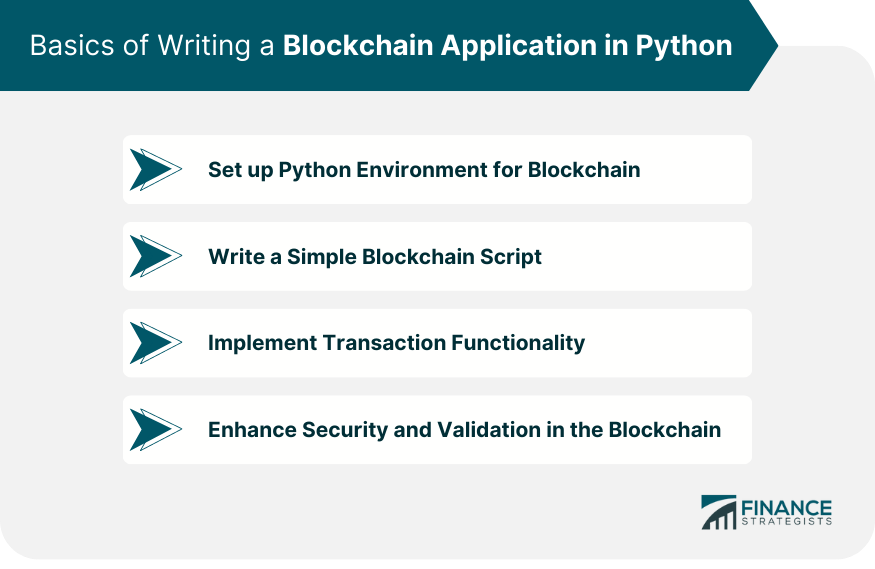
Benefits of Using Python for Blockchain Development
Accessibility and Readability of Python
Availability of Libraries and Tools
Versatility in Building Different Types of Blockchains
Scalability and Performance
Drawbacks of Using Python for Blockchain Development
Limitations in Speed and Performance Compared to Lower-Level Languages
Potential Security Vulnerabilities
Scalability Issues in Large, Complex Blockchains
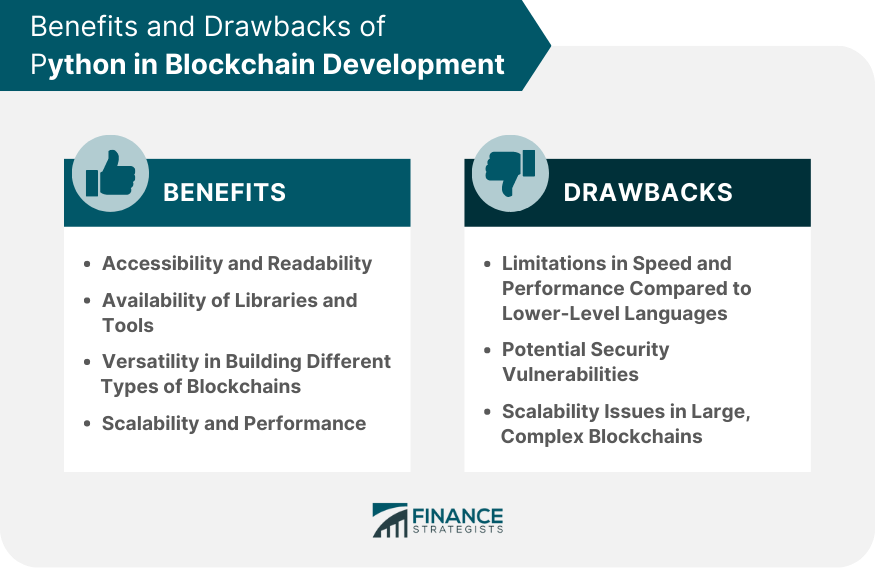
Security Measures in Python Blockchain Development
Data Security and Encryption
Secure Sockets Layer (SSL) and Transport Layer Security (TLS) Protocols
Secure Coding Practices
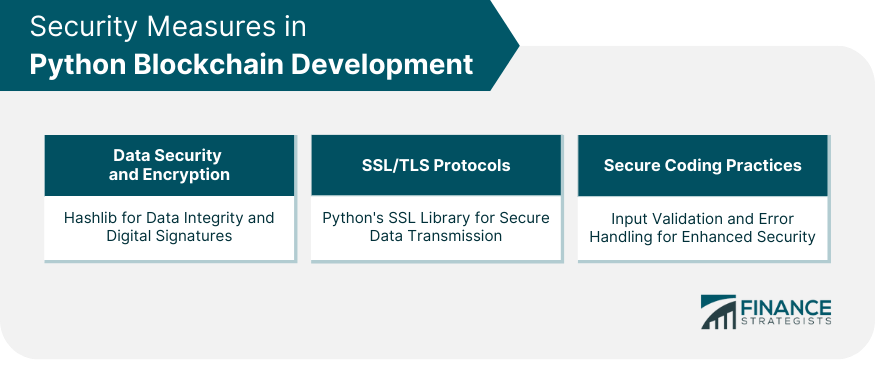
Implementing Smart Contracts With Python
Understand Smart Contracts
Python in Ethereum Smart Contracts
Build Decentralized Apps (DApps) With Python
Conclusion
Blockchain Development With Python FAQs
Blockchain development with Python refers to using Python programming to create decentralized applications (DApps) on a peer-to-peer network.
Python's popularity in blockchain development is due to its simplicity, extensive library ecosystem, and balance between readability and robust capabilities.
Essential Python libraries for blockchain development include hashlib for hash functions, binascii for binary and ASCII conversions, and ECDSA for digital signatures.
While Solidity is commonly used, Python can interact with Ethereum smart contracts using the web3.py library, enabling the deployment and management of smart contracts.
Limitations of using Python in blockchain development include slower performance compared to lower-level languages for large-scale applications and potential scalability issues in complex blockchains.
True Tamplin is a published author, public speaker, CEO of UpDigital, and founder of Finance Strategists.
True is a Certified Educator in Personal Finance (CEPF®), author of The Handy Financial Ratios Guide, a member of the Society for Advancing Business Editing and Writing, contributes to his financial education site, Finance Strategists, and has spoken to various financial communities such as the CFA Institute, as well as university students like his Alma mater, Biola University, where he received a bachelor of science in business and data analytics.
To learn more about True, visit his personal website or view his author profiles on Amazon, Nasdaq and Forbes.















